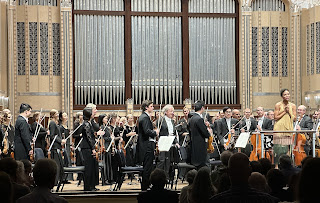The 2024-2025 Cleveland Orchestra season is nearing its end. Music Director Franz Welser-Möst led the orchestra in a typical program which balanced an established older work with a brand-new piece, and an unfamiliar older work.
The concert
began with Mozart’s
Symphony No. 40 in G minor, K. 550. Welser-Möst
has led several Mozart symphonies over the past 23 years of his tenure here,
but this is the first time I’ve heard him in K. 550, a work I know well. Mozart is quietly revolutionary here: the
piece opens not with the “sit up and pay attention” chord that was common with
the time, but a quiet and very brief pulsing passage which leads directly to
the main theme; in the finale, Mozart introduces a transitional passage which includes
11 of the 12-note chromatic scale, with the note of G (the home key of the
work) left out – a technique which is prescient of Arnold Schoenberg. Welser-Möst used a reduced complement of
strings which made it easier for the winds to be heard. The conductor’s tempi, phrasing, balance, and
pacing were just right. The only thing
which detracted from my enjoyment was a small group of audience members who
applauded after the first and second movements. For years, I have considered Mozart’s last
Symphony, No. 41 in C major, K. 551, as my favorite by that composer. But Welser-Möst may have changed my mind and allegiance
to K. 550.
The next
work was a new piece receiving its world premiere this weekend: Allison Loggins-Hull’s Grit. Grace. Glory. This work is optimistic, broadly tonal, and
filled with the spirit of, well, Cleveland.
The opening movement, titled Steel, pulsed with dynamic energy. Shoreline Shadows, the second movement,
stepped back a bit and had moments of reflection – I felt as if I was enjoying
a tranquil day on the shores of Lake Erie.
The third movement, Quip, was self-deprecatingly playful in the way one
often hears in a Haydn menuet or finale.
The finale, Ode, was suffused with the spirit of memories before segueing
into a “Rock and Roll” section which concluded the piece. It’s encouraging to hear music which leaves
the audience enthused, as they were here, instead of baffled.
The last
work on this weekend’s program was the revised
version of Prokofiev’s Symphony No. 4, which, interestingly, was included
on another
program two years ago that also included a premiere of a work by
Loggins-Hull. Welser-Möst’s
interpretation of the work appears to have changed a bit: the outer movements
were broader last night than in 2023. The
central movements just seemed, well, uninteresting. My conclusion leaving the concert was the
exact opposite as two years ago – aside from the opening movement it’s one of
the weakest works of Prokofiev I’ve ever encountered. This may simply be a reflection of my status
last night, as I was tired and recovering an exhausting week that included a recent vaccination. However, the fact that the work has not
crossed my mind over the past two years refutes that supposition.
We’re still
deciding whether to attend next week’s concert presentation of Janáček’s opera Jenůfa.


No comments:
Post a Comment